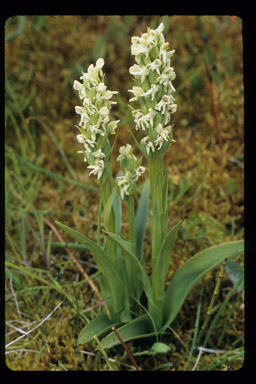Plants 7-35 cm. Leaves few-several, ascending to arcuate-spreading, scattered along stem or clustered at base, sometimes in basal rosette, gradually reduced to bracts distally; blade elliptic-oblong to ovate-oblong or linear-lanceolate, 3-14 × 0.4-4 cm. Spikes lax to very dense. Flowers resupinate, not showy but sometimes conspicuous, yellowish or perhaps whitish green; lateral sepals spreading to slightly reflexed; petals ovate-falcate, margins entire; lip descending, usually ovate with abruptly dilated base or occasionally lanceolate with less prominent dilation, without basal thickening, 4-5.5(-6) × (1.5-)2-2.5 mm; spur clavate, somewhat tapering toward obtuse apex, 4-6 mm; rostellum lobes divergent, directed downward, very small, obscure, rounded; pollinaria straight; pollinia often protruding from anther sacs, commonly fragmenting and pollen masses trailing onto stigma; viscidia linear to linear-oblong; ovary rather slender to stout, mostly 6-10 mm. 2n = 84.
Flowering Jul--Aug. Wet tundra, stream banks; 0 m; Greenland; Iceland.
The relationship between Platanthera hyperborea and P. huronensis is unclear. Typical Icelandic material differs from P. huronensis in its shorter, broader, more extremely dilated, and evidently often yellowish lip; shorter, more strongly clavate spur; and narrower viscidia. The plants furthermore appear to be autogamous. Most Greenland material appears to be entirely comparable to these Icelandic plants. In both areas, however, considerable variation occurs, and some plants suggest P. huronensis. Whether this variation reflects the occurrence in these areas of two taxa or is within P. hyperborea is unknown.
Platanthera hyperborea refers to a bewildering complex that has defied satisfactory treatment. The number and delimitation of species, indeed, the nature of species, in the group is unclear. The system proposed here utilizes more characters than past attempts and it is to be hoped it is an improvement over its predecessors, but it is far from definitive. Hybridization is frequently invoked as an explanation for much of the variation encountered in the group, and some of the possible crossings have been given names. Until species can be properly delimited, however, it is premature to recognize putative hybrids with formal epithets.
Stout, 3-10 dm; lowest lf bladeless; principal foliage lvs lanceolate to oblanceolate, to 25 נ3 cm, the upper smaller and passing into the bracts; spike compact, 6-20 cm, many-fld; bracts lanceolate, the lower 1.5-4 cm; fls erect or appressed, green or greenish-white; lip lance-ovate, 4-7 mm, blunt, gradually and uniformly widened toward the base; lateral pet lanceolate, directed forward and incurved under the upper sep; spur a little shorter than or as long as the lip; 2n=42, 84. Bogs and wet woods; Greenl. and Iceland to Alas., s. to N.J., Pa., Ind., Nebr., and N.M. June-Aug. (Platanthera h.; Limnorchis h.; L. huronensis) A frequent hybrid with no. 5 [Habenaria dilatata (Pursh) Hook.] is H. حedia (Rydb.) Niles.
Gleason, Henry A. & Cronquist, Arthur J. 1991. Manual of vascular plants of northeastern United States and adjacent Canada. lxxv + 910 pp.
©The New York Botanical Garden. All rights reserved. Used by permission.








